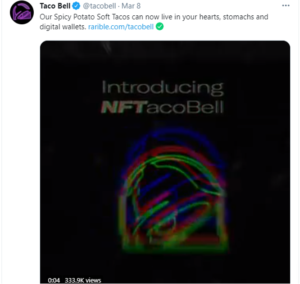Unless you’ve been living under a rock, you’ve probably either invested in Bitcoin, contemplated investing in Bitcoin, have been confused out of your mind about what cryptocurrency is, or thought that investing in Bitcoin is the most absurd thing you’ve ever heard of, because money is money, and code on a computer can’t possibly be money.
Well, if you thought Bitcoin (a fungible / interchangeable asset like gold or fiat currency or lettuce) was fascinating, do yourself a favor and wrap your head around NFTs, shorthand for non-fungible tokens, a new class of digital assets that is rising in popularity mainly because each individual asset is unique and therefore can assume a different value, like pieces of art.
For those of us who live and breathe marketing and advertising, NFTs represent a generational opportunity to craft a new dynamic around the relationships people have with brands, providing truly enterprising brands a viable competitive advantage in a world where attention spans and brand loyalty are dwindling at historic rates.
Digital assets are increasingly compelling for several reasons. First, we live in an increasingly digital world. Younger generations don’t even distinguish between physical and digital like those of us who remember a time when regular people couldn’t logon to the Internet. There’s a fluency that comes with digital nativity, an acceptance of – and even a preference for – things and experiences that originate and remain within the confines of a screen, rather than in “real life”, so it’s not shocking that just like a 60-year-old might find it completely normal and commonplace to admire her art collection as she walks through her home, a 20-year-old wouldn’t find it the least bit strange to admire his art collection solely through a device connected to the web.
Digital assets also don’t degrade like physical assets, and at least in theory, they are and always will remain verifiable, preventing fakes and fraud that are rampant in almost every category of physical assets. There’s a growing distrust of institutions that’s permeated youth culture, and because digital assets have their ownership, history and unique identity traced back to the blockchain in perpetuity, the built-in level of transparency and authenticity is reassuring. And like any class of assets, value is determined by supply and demand.
But what’s most interesting to marketers is the opportunity NFTs offer to elevate the relationship between a brand and its consumers. One of the realities that has defined the digital era is we’ve moved from a world of scarcity to a world of abundance, with instant access to infinite information, connection, entertainment, and shopping options with the click of a button. So, while social channels like Facebook and Instagram continue to reign supreme as collaborative destinations where brands can connect with their most important consumers and earn their loyalty and evangelism, for those consumers who want more – access, connection, sense of belonging, involvement, equity – NFTs present an awfully compelling proposition.
Tactically, NFTs can be used to represent any type of digital file – art, audio, video – ideal for brand storytelling. More importantly, NFTs can be used to prove or even convey ownership or access to any sort of experience a brand wants to offer its consumers. Consumers have an opportunity to genuinely feel like they have a stake in the brands they care about most, and brands have an opportunity to build, foster and reward a community of true advocates, where both parties have a vested interest in the success of one another.
Taco Bell has long supported causes their customers deeply care about, and this year they sold taco-themed NFT GIFs to raise money for the Live Mas Scholarship. Within 30 minutes, all 25 NFTacoBells sold for thousands of dollars each, and the owners of each NFT can resell them to future buyers as the digital assets rise in value.

Little-known Chinese virtual sneaker brand RTFKT was looking to disrupt the market and build brand awareness, so they designed an NFT sneaker for the Chinese New Year and auctioned it for $28,000, incredibly impressive until you recognize that they sold another NFT sneaker designed in collaboration with artist FEWOCIOUS for $3 million.

Kings of Leon launched their new album, “When You See Yourself”, in the form of an NFT, using three types of tokens in this first-of-its-kind album release. One type of token features a special album package, the second offers live show perks, and the third features exclusive audiovisual art. The sale of the NFTs was only open for 2 weeks, after which no additional album tokens would ever be offered, in effect turning the tokens into tradeable collectibles.

NFTs can unlock special giveaways, rewards, or pricing. They can unlock limited resources, like access to a VIP conference or even lunch with a brand’s CEO. Ownership of exclusive NFTs will give people a deeper sense of connection with their favorite brands, which will undoubtedly translate into increased loyalty. And since any brand NFT can be sold on secondary markets for profits in the future, it’s also an interesting new way for consumers to literally invest in their favorite companies.
Non-fungible tokens have opened limitless new avenues for interacting with a brand’s audience, creating memorable experiences or access to both tangible and intangible benefits as a byproduct of being connected. And as the lines between physical and digital continue to blur, with each new generation of consumer living a digital-first life, the implications are vast.
The only question is, how can YOUR brand capitalize on the NFT movement?


